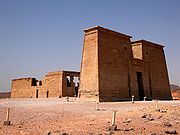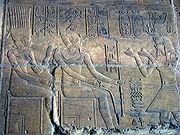
Temple of Dakka
Encyclopedia


Nubia
Nubia is a region along the Nile river, which is located in northern Sudan and southern Egypt.There were a number of small Nubian kingdoms throughout the Middle Ages, the last of which collapsed in 1504, when Nubia became divided between Egypt and the Sennar sultanate resulting in the Arabization...
, which was located approximately 100 km south of the Aswan. The Greco-Roman Temple of Dakka, dedicated to Thoth
Thoth
Thoth was considered one of the more important deities of the Egyptian pantheon. In art, he was often depicted as a man with the head of an ibis or a baboon, animals sacred to him. His feminine counterpart was Seshat...
, the god of wisdom, was initially a small one room shrine or chapel which that was first begun in the 3rd century BC by a Meroitic king named Arkamani (or Ergamenes II) in collaboration with Ptolemy IV who added an antechamber and a gate structure. Ptolemy IX "subsequently enlarged the temple by adding a pranaos with two rows of probably three columns." During the Roman period, the Emperors Augustus and Tiberius further enlarged the structure with "the addition, at the rear, of a second sanctuary as well as inner and outer enclosure walls with a large pylon. The sanctuary contained a granite naos." The Temple of Dakka was transformed into a temple fortress by the Romans and surrounded by a 270 X 444 metre long stone wall with an entrance along the Nile.
A large dromos leads to the pylon which formed the entrance to the temple and each of the pylon's towers are decorated in high relief and bear numerous graffiti from visitors, mostly in Greek but some in Demotic and Meroitic script. Inside the gateway, the Meroitic king Arqamani "is shown on the left sacrifing to Thoth, with Tefnut and Hathor above and Isis below." There are reliefs of cows offered as gifts to the god Thoth carved into the naos of the Temple of Dakka. While the temple of Dakka was similar architecturally to the temple of Wadi es-Sebua
Wadi es-Sebua
Wadi es-Sebua, or Valley of the Lions , is the site of two New Kingdom Egyptian temples, including one impressively large temple spéos of Ramesses II, at the edge of Nasser lake in Lower Nubia. The first temple was built by Amenhotep III and subsequently restored by Ramesses II...
, it lacked a front courtyard of sphinxes; however, its 12 metre high pylon is in near perfect condition. A 55 metre long processional approach ran from the temple's pylon to a cult terrace at the Nile. During the Christian period of Egypt, the facade of the pranaos was converted for use into a church and Christian paintings were still visible here in the 20th century before the temple was enveloped by the Nile floods.
The temple of Dakka collapsed in 1908-1909 and was subsequently rebuilt by Alessandro Barsanti
Alessandro Barsanti
Alessandro Barsanti was an Italian architect and Egyptologist who worked for the Egyptian Antiquities Service. He excavated throughout Egypt . He was also in charge of the transfer of collection of the Cairo Museum from its site at Giza to the current location in Cairo itself.-References:...
.
Relocation of Temple
With the construction of the Aswan damAswan Dam
The Aswan Dam is an embankment dam situated across the Nile River in Aswan, Egypt. Since the 1950s, the name commonly refers to the High Dam, which is larger and newer than the Aswan Low Dam, which was first completed in 1902...
in the 1960s, the temple was dismantled and moved to the site of Wadi es-Sebua
Wadi es-Sebua
Wadi es-Sebua, or Valley of the Lions , is the site of two New Kingdom Egyptian temples, including one impressively large temple spéos of Ramesses II, at the edge of Nasser lake in Lower Nubia. The first temple was built by Amenhotep III and subsequently restored by Ramesses II...
some 40 km upstream between 1962 and 1968. At the time of its removal, some reused stone blocks from Thutmose III
Thutmose III
Thutmose III was the sixth Pharaoh of the Eighteenth Dynasty. During the first twenty-two years of Thutmose's reign he was co-regent with his stepmother, Hatshepsut, who was named the pharaoh...
, Seti I
Seti I
Menmaatre Seti I was a Pharaoh of Ancient Egypt , the son of Ramesses I and Queen Sitre, and the father of Ramesses II...
and Merneptah
Merneptah
Merneptah was the fourth ruler of the Nineteenth Dynasty of Ancient Egypt. He ruled Egypt for almost ten years between late July or early August 1213 and May 2, 1203 BC, according to contemporary historical records...
were discovered which originated from an earlier New Kingdom
New Kingdom
The New Kingdom of Egypt, also referred to as the Egyptian Empire is the period in ancient Egyptian history between the 16th century BC and the 11th century BC, covering the Eighteenth, Nineteenth, and Twentieth Dynasties of Egypt....
structure in or near Kubban. Today, the Temple of Dakka sits dramatically on a small bluff and is the only Nubian temple with a facade that faces to the north and enjoys a north-south orientation to parallel the course of the Nile. The temple's pylon is now separated from the remainder of the temple due to the missing enclosure walls of the open court.
The Temple of Maharraqa
Temple of Maharraqa
Al-Maharraqa is a place in Lower Nubia, which was approximately 120 km south of Aswan on the southern border of the Roman empire. Only a few years after the Roman conquest of Egypt in 30 BC, the Kushites from the kingdom of Meroë launched a raid on the First cataract region of Egypt in 23 BC...
was also moved and rebuilt at the New Wadi es-Sebua
New Wadi es-Sebua
The site of New Wadi es-Sabua, which is located only 4 km west from the original site of Wadi es-Sebua, is today home to three Ancient Egyptian temples in Lower Nubia, the temples of Wadi-es Sebua, Maharraqa and Dakka respectively.-Wadi es-Sabua Temple:...
temple complex area.

